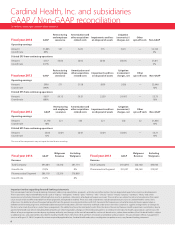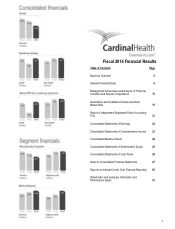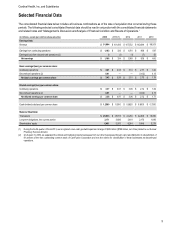Cardinal Health 2014 Annual Report Download - page 18
Download and view the complete annual report
Please find page 18 of the 2014 Cardinal Health annual report below. You can navigate through the pages in the report by either clicking on the pages listed below, or by using the keyword search tool below to find specific information within the annual report.
Cardinal Health, Inc. and Subsidiaries
Management's Discussion and Analysis of Financial Condition
and Results of Operations
16
reviewing accounts receivable aging, industry trends, customer
financial strength and credit standing, historical write-off trends
and payment history. We also regularly evaluate how changes
in economic conditions may affect credit risks.
Our methodology for estimating the allowance for doubtful
accounts is assessed annually based on historical losses and
economic, business and market trends. In addition, the
allowance is reviewed quarterly and updated if appropriate. We
may adjust the allowance for doubtful accounts if changes in
customers’ financial condition or general economic conditions
make defaults more frequent or severe.
The following table gives information regarding the allowance
for doubtful accounts over the past three fiscal years:
(in millions, except percentages) 2014 2013 2012
Allowance for doubtful accounts $ 156 $ 152 $ 143
Reduction to allowance for customer
deductions and write-offs 51 34 30
Charged to costs and expenses 51 41 22
Allowance as a percentage of customer
receivables 2.8% 2.3% 2.2%
Allowance as a percentage of revenue 0.17% 0.15% 0.13%
A hypothetical 0.1 percent increase or decrease in the reserve
as a percentage of trade receivables and finance notes
receivables at June 30, 2014, would result in an increase or
decrease in bad debt expense of $6 million.
We believe the reserve maintained and expenses recorded in
fiscal 2014 are appropriate. At this time, we are not aware of
any analytical findings or customer issues that might lead to a
significant future increase in the allowance for doubtful accounts
as a percentage of revenue.
Inventories
A substantial portion of our inventories (61 percent and 65
percent at June 30, 2014 and 2013, respectively) are valued at
the lower of cost, using the last-in, first-out ("LIFO") method, or
market. These are primarily merchandise inventories at the core
pharmaceutical distribution facilities within our Pharmaceutical
segment. The LIFO impact on the consolidated statements of
earnings in a given year depends on pharmaceutical price
appreciation and the level of inventory. Prices for branded
pharmaceuticals generally tend to rise, which results in an
increase in cost of products sold, whereas prices for generic
pharmaceuticals generally tend to decline, which results in a
decrease in cost of products sold.
The LIFO method presumes that the most recent inventory
purchases are the first items sold, so LIFO helps us better match
current costs and revenue. Using LIFO, if there is a decrease
in inventory levels that have experienced pharmaceutical price
appreciation, the result generally will be a decrease in future
cost of products sold as our older inventory is held at a lower
cost. Conversely, if there is a decrease in inventory levels that
have experienced a pharmaceutical price decline, the result
generally will be an increase in future cost of products sold as
our older inventory is held at a higher cost. We believe that the
average cost method of inventory valuation reasonably
approximates the current cost of replacing inventory within the
core pharmaceutical distribution facilities. Accordingly, the LIFO
reserve is the difference between (a) inventory at the lower of
LIFO cost or market and (b) inventory at replacement cost
determined using the average cost method of inventory
valuation.
The remaining inventory is stated at the lower of cost, using the
first in, first out method, or market. If we had used the average
cost method of inventory valuation for all inventory within the
Pharmaceutical distribution facilities, the value of our inventories
would not have changed in fiscal 2014 or 2013. Primarily
because prices for our generic pharmaceutical inventories have
declined over time, inventories valued at LIFO were $98 million
and $97 million higher than the average cost value at June 30,
2014 and 2013, respectively. We do not record inventories in
excess of replacement cost. As such, we did not record any
changes in our LIFO reserve in fiscal 2014 and 2013.
Inventories presented in the consolidated balance sheets are
net of reserves for excess and obsolete inventory which were
$44 million and $40 million at June 30, 2014 and 2013,
respectively. We reserve for inventory obsolescence using
estimates based on historical experience, sales trends, specific
categories of inventory and age of on-hand inventory. If actual
conditions are less favorable than our assumptions, additional
inventory reserves may be required.
Business Combinations
The assets acquired and liabilities assumed in a business
combination, including identifiable intangible assets, are based
on their estimated fair values as of the acquisition date. The
excess of the purchase price over the estimated fair value of
the net tangible and identifiable intangible assets acquired is
recorded as goodwill. We base the fair values of identifiable
intangible assets on detailed valuations that require
management to make significant judgments, estimates and
assumptions. Critical estimates and assumptions include:
expected future cash flows for customer relationships,
trademarks, trade names, developed technology and other
identifiable intangible assets; discount rates that reflect the risk
factors associated with future cash flows; and estimates of
useful lives. When an acquisition involves contingent
consideration, we recognize a liability equal to the fair value of
the contingent consideration obligation at the acquisition date.
The estimate of fair value of a contingent consideration
obligation requires subjective assumptions to be made
regarding future business results, discount rates and
probabilities assigned to various potential business result
scenarios. Subsequent revisions to these assumptions could
materially change the estimate of the fair value of contingent
consideration obligations and therefore could materially affect
























